|
Report from
Europe
Price inflation drives rise in value of UK tropical wood
product imports
The import value of tropical wood and wood furniture into
the UK in the opening four months of this year were at an
unprecedented level of US$565 million (Chart 1). That is
36% more than the same period in 2021 when imports
were also high following a strong rebound after the
downturn during the first COVID lockdown in 2020.
In fact, this was by far the strongest start to the year in
terms of UK import value of tropical wood and wood
furniture products since at least before the 2008 financial
crises. It compares to an average import value of less than
US$380 million for the January to April period throughout
the whole decade prior to the onset of the pandemic in
2019.
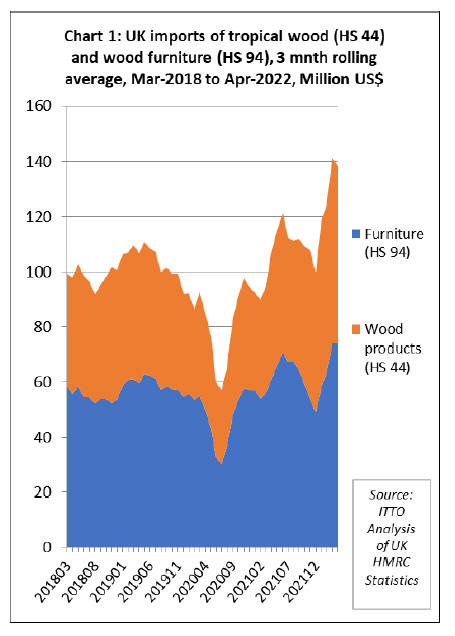
The rise in UK import quantity of tropical wood and wood
furniture was much less dramatic in the first four months
of this year, at 118,000 tonnes, just 10% more than the
same period in 2021. This shows that price inflation was
the major factor behind the rise in import value.
Significant weakening of the value of the GBP on foreign
exchange markets since the end of April, combined with
the wider geo-political situation, implies that price
inflation will remain a key issue for UK importers in the
months of ahead. It also indicates that the current boom in
UK imports may well be short-lived.
Availability of hardwood and furniture products from the
UK's traditionally largest suppliers in Europe has become
even more challenging since Russia's invasion of Ukraine
encouraging importers to look more to tropical products.
COVID lockdowns have also seriously disrupted
availability of manufactured wood products from China.
Hardwood product prices were declining steadily from the
middle of last year to February this year. Even in February
prices remained at historically high levels and the
downward trend has reversed since Russia¡¯s invasion of
Ukraine. UK government figures indicate that average
timber prices at point of sale to UK building firms were
30% up in the year to April 2022, compared with a year
earlier.
Freight rates also declined from the heights reached in the
third quarter of last year but are still at a historically very
high level. For example, the cost of a 40ft container from
China into the UK was US$11,000 at the start of this
month, less than its peak of US$14,700 in October, but a
huge rise from US$1,500 in summer 2020.
The war in Ukraine has seriously disrupted all supplies of
European and Russian hardwood products, partly because
of the direct effects of sanctions against Russia, partly the
immediate effects of the war on Ukrainian supply, and
partly because of the large numbers of Ukrainians, who
contribute a disproportionately large number of truck
drivers operating in Europe, who returned home during the
conflict. The war has also driven up energy costs, filtering
through into rising prices for all European manufactured
products, including for wood and furniture.
While higher import prices were the major driver of
increased UK import value in the opening months of this
year, the trend was partly due to continuing high
consumption in the UK, supported by post-COVID
government stimulus. Demand during this period was
particularly strong in housing repair, maintenance, and
improvement, a major source of hardwood demand and the
fastest growing part of the UK construction sector
following the initial COVID lockdown.
According to the UK Construction Products Association
latest survey, nearly half of materials firms in the UK said
sales had jumped in the first three months of 2022
compared to the fourth quarter of last year. Increased sales
were reported by around 50% of so-called ¡°light side¡±
manufacturers of products like windows, doors and
kitchens.
However, prospects for the UK economy for the rest of
this year are far from promising. Economists have said it is
increasingly likely that the UK will sink into recession this
year. In June, the Paris-based OECD cut its UK growth
forecast for 2023 to zero, the lowest in the G20. Also in
June, the Bank of England raised interest rates to 1.25 per
cent to tackle fast rising inflation, which is expected to
reach 11% by October.
The latest S&P Global / CIPS UK Construction
Purchasing Managers Index (PMI) report for May
indicates that the wider economic slowdown is beginning
to filter through into declining UK construction sector
activity. The report notes that "Though still offering a
comfortable margin above the no change mark, the
construction sector saw growth ease to a four-month low
with the usual suspects taking the heat out of the recovery
¨C elevated inflation, future uncertainty and supply-chain
disruption¡±.
The PMI report goes on to say that ¡°The UK housing
sector in particular showed further signs of fragility with
the worst performance since May 2020 and moving closer
to the danger zone of negative territory. Affordability
concerns will be weighing on the mind of potential house
buyers grappling with escalating costs for everyday items,
resulting in a postponement of big purchases until the UK
economy shows more resilience¡±.
Furthermore, "The lack of positive sentiment was also
reflected in construction companies¡¯ confidence over the
next 12 months, with optimism dropping to the weakest
since August 2020¡±.
The PMI report also suggests that recent strong material
purchases in the UK construction sector are partly driven
by a desire to beat anticipated price increases in the
months ahead as inflation rates are exceedingly high.
Indonesia leads rise in tropical wood furniture imports
into the UK
The UK imported US$284 million of tropical wood
furniture products in the first four months of 2022, which
is 23% more than the same period in 2021. In quantity
terms, wood furniture imports were 64,000 tonnes during
the four month period, the same level as the previous year.
This indicates that the rise in value was driven more by
price inflation than strong demand.
Import values increased from all four of the leading
tropical supply countries to this market in the opening four
months of this year compared to last including Vietnam
(+28% to US$147 million), Malaysia (+7% to US$56
million), Indonesia (+59% to US$39 million) and India
(+39% to US$36 million). Imports from Singapore, which
increased sharply last year due to shipping problems
elsewhere in Southeast Asia, fell back 59% to more a
"normal" level of just US$5 million in the four month
period (Chart 2).
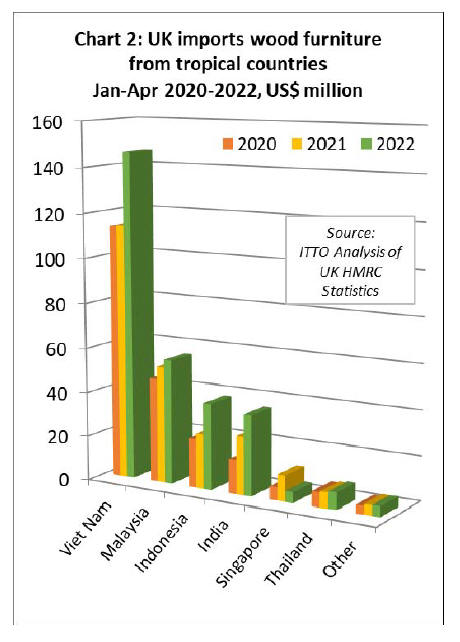
UK tropical wood imports up 72% in the first two
months of 2022
Total UK import value of all tropical wood products in
Chapter 44 of the Harmonised System (HS) of product
codes were US$271 million between January and April
this year, 55% more than the same period in 2022. In
quantity terms imports increased 16% to 118,000 tonnes
during the period.
Compared to the first four months last year, UK import
value of tropical joinery products increased 46% to
US$112 million, import value of tropical plywood was up
30% to US$65 million, import value of tropical sawnwood
increased 100% to US$46 million, and import value of
tropical mouldings/decking also increased 100% to US$13
million (Chart 3).
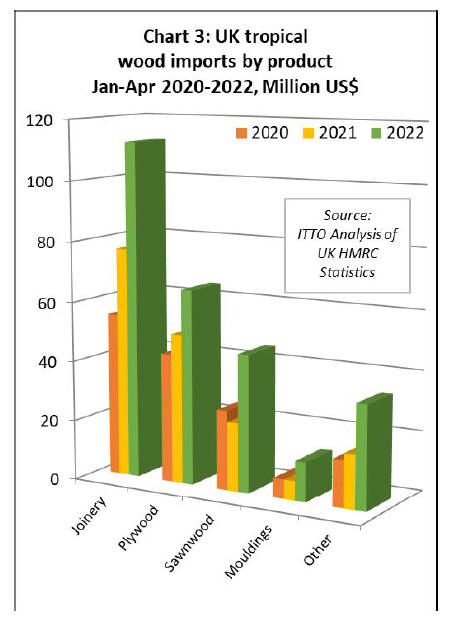
After the sharp dip in UK imports of tropical joinery
products during the first lockdown period in the second
quarter of 2020, imports of this commodity group have
progressively built momentum.
This trend is mainly driven by Indonesia for which UK
joinery imports, mainly consisting of doors, were US$61
million in the first four months this year, 34% more than
the same period in 2021 (Chart 4). In quantity terms, UK
joinery imports from Indonesia were 19,000 tonnes in the
first four months of this year, 6% more than the same
period in 2021.

UK imports of joinery products from Malaysia and
Vietnam (mainly laminated products for kitchen and
window applications) started this year more slowly.
Import value from Malaysia was US$15 million in the
January to April period, 23% less than the same period last
year. In quantity terms, imports from Malaysia were 4,800
tonnes, 35% less than the same period in 2021. Joinery
imports from Vietnam of 834 tonnes valued at US$3
million were respectively 39% and 26% less than the same
period last year.
UK imports of Chinese tropical joinery products, nearly all
comprising doors, were 6,200 tonnes with value of US$17
million in the first four months of 2022, up from negligible
levels in previous years. Due to introduction from 1st
January 2022 of new product codes in the EU Combined
Nomenclature (still mirrored by the UK post-Brexit) it is
now possible to identify wood doors and windows
manufactured using a wider range of tropical wood species
in UK and EU trade statistics.
The apparent rise in imports of "tropical" wood joinery
from China is very likely due to these products now being
identifiable as of tropical species, whereas previously they
were classified as "other non-coniferous" in the trade
statistics and excluded from the figures for tropical wood
imports.
In the first four months of 2022, the UK imported 45,400
tonnes of tropical hardwood plywood, 6% less than the
same period last year. Tropical hardwood plywood
imports from Indonesia have made gains this year, while
imports from China have continued to slide (Chart 5).
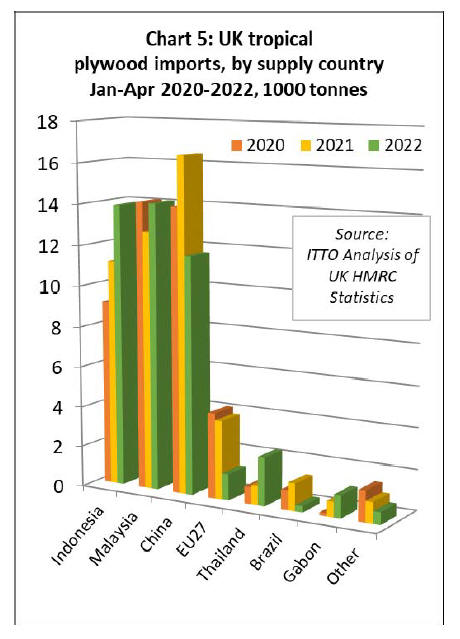
The UK imported 13,900 tonnes of tropical plywood from
Indonesia in the first four months of this year, a gain of
25% compared to the same period last year. Imports from
Indonesia, which increased sharply in the first two months
of the year, slowed in March and April.
In contrast, UK plywood imports from Malaysia were very
slow in the opening two months this year but strengthened
in March and April. By the end of the first four months,
the UK had imported 14,100 tonnes of plywood from
Malaysia, 11% more than the previous year.
The UK imported 11,700 tonnes of tropical hardwood
plywood from China in the first four months this year,
29% less than the same period in 2021, trade having been
affected by COVID lockdowns in China. At the same
time, Brexit is impacting on UK imports of tropical
hardwood plywood from EU countries which were just
1,300 tonnes in the opening four months of this year. This
compares to around 4,000 tonnes during the same period
in the last two years.
Shift in countries supplying tropical sawnwood to the
UK
UK imports of tropical sawnwood started this year
strongly. Imports were 25,600 tonnes in the first four
months of 2022, 50% more than the same period last year.
In addition to making major gains overall, there were big
changes in the countries supplying tropical sawnwood to
the UK in the opening months of this year (Chart 6).
This is indicative of the major shifts in hardwood markets
since the start of the pandemic which have led to
significant supply shortages and sharply increasing prices
in many supply regions and continuing high levels of
demand in markets like the UK.
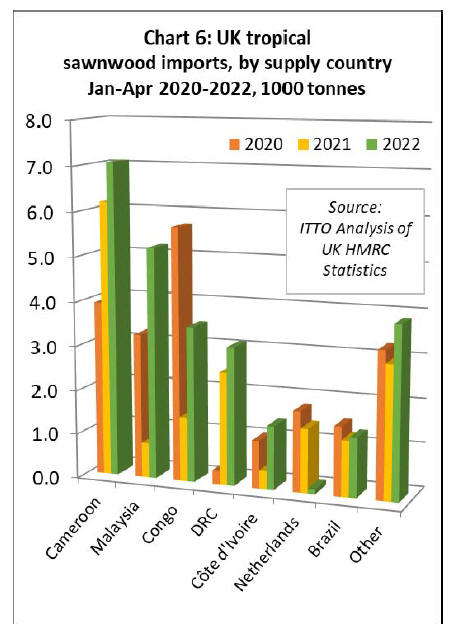
UK imports of tropical sawnwood from Cameroon were
7,100 tonnes in the first four months of this year, 14%
more than the relatively high level in the same period last
year. UK imports from Malaysia, which had fallen to little
more than a trickle in recent years, were 5,200 tonnes in
the first four months this year, nearly a 6-fold increase
compared to the same period last year.
UK imports of tropical sawnwood from the Republic of
Congo (RoC) were 3,500 tonnes in the first four months of
this year, nearly three times the level of last year but still
well down on the pre-pandemic level. Meanwhile there
has been a significant rise in UK imports of sawnwood
from DRC, which were 3,100 tonnes in the first four
months this year, a gain of 23% compared to the same
period last year.
UK imports from DRC were negligible before the
pandemic. UK imports of tropical sawnwood from Côte
d'Ivoire were 1,400 tonnes in the first four months this
year, a 240% increase compared to negligible imports in
the same period last year.
Imports of tropical hardwood sawnwood from Brazil were
1,300 tonnes in the first four months of this year, 6% more
than the same period last year but still down on the prepandemic
level.
Indirect UK imports of tropical sawnwood from EU
countries have fallen dramatically since the UK¡¯s
departure from the EU single market on 1st January 2021.
Total UK imports from EU countries were 1,600 tonnes in
the first four months of this year, 48% less than the same
period last year.
UK imports of tropical hardwood mouldings/decking were
relatively high in the opening four months of 2022, at
4,500 tonnes, 87% more than the same period the previous
year. This is another commodity group for which there has
been particularly strong demand in the UK, combined with
sharply tightening supply since the start of the pandemic.
The war in Ukraine and sanctions on Russia are expected
to lead to even tighter supplies of non-tropical decking
products that directly compete with tropical decking in the
short to medium term.
UK imports of decking/mouldings increased sharply from
Indonesia and Brazil in the first four months of this year.
Imports of 1,600 tonnes from Indonesia were 128% more
than the same period last year. Imports of 1,200 tonnes
from Brazil were 113% up on the same period in 2021.
Imports from Malaysia increased 21% to 1,000 tonnes
during the four month period. (Chart 7).

Leading media outlets highlight mounting concern
over European wood supply
The extent of concern surrounding disruption to wood
supplies in Europe due to the war in Ukraine is highlighted
by this issue now being the focus of reports by mainstream
media outlets in the region.
On 19 June, the London-based Financial Times (FT)
published an article under the headline ¡°Ukraine war hits
global timber trade and adds to risks for forest¡±
(https://www.ft.com/content/d6388b32-757b-4484-95ff-720b4b2319f3).
The articles notes that ¡°The war in Ukraine has caused
serious disruption to the global timber trade and increased
concerns over forest destruction as exports are interrupted,
environmental protections are lifted and Kyiv redirects
manpower away from fighting wildfires to the front line¡±.
The FT reports that international sanctions imposed over
Moscow¡¯s invasion of Ukraine have curbed supplies from
Russia, the world¡¯s largest exporter of softwood timber,
and Belarus, while the conflict has severely hampered
production in Ukraine.
It is noted that ¡°the three countries accounted for a quarter
of the worldwide timber trade last year, according to
industry figures. They exported 8.5mn cubic metres of
softwood to Europe last year, just under 10 per cent of the
region¡¯s demand. Russia, the world¡¯s largest exporter of
softwood, alone produces about 40mn cubic metres a
year¡±.
¡°Timber producing and exporting nations are taking steps
to make up the shortfall, including loosening some
environmental protections to increase production¡±,
according to the FT. In Ukraine itself, the FT notes that
¡°Soon after February¡¯s invasion, Kyiv lifted a regulation
that prohibits logging in protected forests during spring
and early summer, as part of a bill to increase the
country¡¯s defence capabilities during martial law, partly
by boosting export earnings¡±.
The FT quotes Ukraine¡¯s environmental protection
ministry as stating earlier this year that ¡°the sanctions
offered the country the chance to increase its share of the
European timber market in Russia¡¯s place and boost
financing of post-war reconstruction efforts¡±.
The FT goes on to suggest that ¡°Other exporters including
Estonia, Finland and the US are also seeking to increase
logging volumes. In the US, the House Committee on
Natural Resources in April introduced the No Timber
From Tyrants bill, which would ban imports of wood
products from Russia and Belarus and authorise an
equivalent amount of domestic harvesting in 2021 to make
up for lost imports¡±.
According to the FT, ¡°Earlier this month Estonia
announced a relaxation of logging restrictions on stateowned
land, which is home to about half of the country¡¯s
forests. As a result, the area of land logged will increase
by almost a quarter to 2,400 hectares¡± and ¡°Finland is
expected to boost harvesting volumes by 3 per cent for
each of the next two years¡±.
Another recent mainstream media article ¨C this one in
Dezeen published 17 June, one of the world¡¯s most
influential architecture, interiors and design magazines
(https://www.dezeen.com/2022/06/17/timber-shortageukraine-
war-news/) states that ¡°architects and designers
are struggling to source wood for their projects as Russia's
invasion of Ukraine has brought imports from the region
to a standstill, threatening stocks and driving up prices
across the continent¡±.
According to Dezeen, studios in Europe are ¡°reporting that
costs for solid oak and birch plywood have doubled in the
last few months, while others have seen the price of
structural timber go up by around 20 per cent¡±. The article
quotes Sean Sutcliffe, co-founder of British furniture
maker Benchmark: "Everyone is really worried about
their supply chains. We have projects where it would now
cost me more to buy the wood that I'm charging for the
whole thing." Birch plywood is "just not available
anymore", Sutcliffe said.
In another quote, Signe Bindslev Henriksen of Danish
design studio Space Copenhagen is reported as saying that
solid oak ¡°is almost like gold at the moment. Everybody is
using up all their stock. Suppliers and manufacturers can
deliver right now but in just a few months' time, it'll be all
gone."
Dezeen notes that while most European wood imports
from Russia, Belarus and Ukraine go to the Baltic states,
Germany and Finland, ¡°architects and designers say the
knock-on effects are being felt across Europe.¡±
Sean Sutcliffe is reported as saying that "we didn't
actually buy any Ukrainian or Russian wood. But of
course, all the people that did are now crowded into
Western Europe, which is where our supply chain comes
from." Due to svere shortages of European oak,
Benchmark are reported to be making all new products
presented at Clerkenwell Design Week last month from
local British ash and American red oak.
|